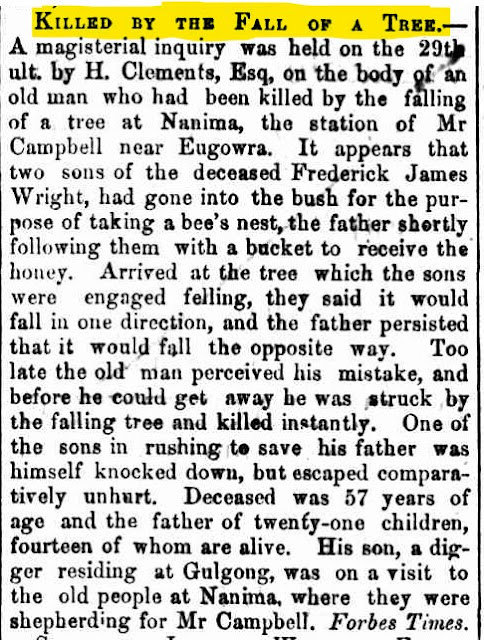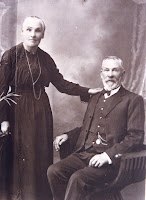Our Common Ancestors are: William Henry Browning and Anne (Nancy) Littlejohns, my great great great grandparents, and Hannah's parents.
 |
| Transcription of Baptism Record 1825 |
Hannah Browning was born in July of 1825 in Launceston, Cornwall, England. Whilst the information on her immigration record indicates she was born in 1824 and stating that she would be turning 16 on her birthday in 1840; the baptism transcription from the Cornwall Family History Society shows her baptism occurring in 1825.
Unlike the experiences Hannah would go through trying to get her own children baptised in Australia, waiting sometimes for nearly a year or longer until a clergyman or priest would visit the area on horseback; in England, children were generally baptised quite soon after their birth because churches, clergymen or priests were close by and easily accessible. I feel it's more accurate to say that Hannah was born in 1825.
At the time of her birth, Hannah's father William was aged 24 and her mother Anne (known as Nancy) was 23. There was only one other sibling then, but over the following 22 years Hannah was to become an older sister to nine more.
In 1825, Hannah's father was working as a labourer, and the family was living at the 'Fish Market'. I don't think much imagination is needed to understand exactly what that meant! Poverty! Life would have been extremely difficult and it's likely they all experienced hunger and deprivation on a daily basis.
The family had moved to Devon by the time Hannah's brother John Thomas was born in 1827. It seems likely that Hannah's father had moved back to his birthplace, perhaps seeking assistance from his family and/or seeking work.
Within five years however, the family was back in Launceston, Cornwall, where my great grandmother Caroline, Hannah's sister, was born in the poor house. I guess that Hannah would have been living with her family in the poor house at the time, when she was only four years old. Times were obviously extremely tough for the family and this no doubt left an indelible impression upon the young Hannah.
Hannah's parents remained in Launceston where they welcomed the birth of William Henry in 1832, when Hannah was 7. At this time the family were living in Fore Street, Launceston and there's an extremely vivid picture of life on that street, written by a man by the name Richard Robbins in his text "Reminiscences of Launceston Town 1820 to 1830". In the section titled 'Sanitation', Richard wrote:
Hannah's parents made the decision at the start of 1840 to look elsewhere for their future and the future of their six children. This decision coincided with the introduction of the Bounty system of migration to Australia.
The Browning family fitted the scheme very well as the colonial government was looking for healthy young couples with children, and preferably daughters of a marriageable age which would benefit a colony filled to the brim with young men looking for a bride. In 1840, when the family arrived in Australia, they had two such daughters - Susannah, aged 16 and Hannah, aged 14.
Hannah lived in an age when women were generally considered as property and their sole purpose was to breed, care for the family and the home (if they had one!). I'm sure her father and mother made the decision to leave their home and family ties at great cost, firmly believing that there was a better future in the colonies. No doubt, they knew that marriage prospects for their daughters were significantly better in the colonies, but I do wonder if Hannah fully understood the implications of the move to Australia.
She did go on to make a very, very significant contribution to the populating of the expanding colony and went above and beyond the expectations that sat firmly on her shoulder when she disembarked the ship 'Premier' on July the 2nd, 1840, just a few days before her 15th birthday!
In January of 1842, Hannah married Thomas Norton, an employee of the A. A. Company. Thomas was a convict and required the permission of the Government to marry as he was still serving his sentence, although he had received his ticket of leave during 1841 and was working on the same property as Hannah's family.
Permission was granted on December 17th 1841, and then the marriage took place at Stroud, in northern New South Wales, the following January. Thomas was 37 and Hannah was 16. Hannah's elder sister Susannah and her new husband Joshua Craven acted as witnesses.
A year and a half later, sadly Hannah's beloved older sister Susannah died in late 1843.
Not much is known about Hannah's life with Thomas apart from the fact they welcomed a baby daughter named Mary Ann in May of 1846, when Hannah was aged 20. Hannah and Thomas were living in Singleton at this time, still moving around wherever Thomas's work with the pastoral company took him. Tragically, Thomas died not long after and Hannah was widowed at the age of 21.
 |
2nd husband, James Wright c. 1870 |
Widowhood did not last long though, and Hannah married again in August of 1848. Her second husband was James Wright, aged 26.
They would have married at the sheep and cattle station where they were both employed. It's highly likely they were married in an open-air ceremony as there was no nearby church or place of worship.
The Anglican clergyman who performed the ceremony was a travelling minister, attached to the St. John Parish based in Brisbane. He engaged in long pastoral tours around the Darling Downs region and people took advantage of his intermittent visits to arrange special events such as a wedding.
 |
| Marriage Record 1848 James Wright and Hannah Norton nee Browning Witnesses: Charlotte Sutton and William Browning (Hannah's father) Celebrant: Rev. Benjamin Glennie |
Hannah and James had met while both were working at Maryland Station. Hannah was working alongside her parents as shepherds on the station. Shortly after her second marriage, Hannah moved to the neighbouring property, Ballendean, with her husband. That's where she gave birth to her first set of twins ... yes, I said 'first', because there several more sets to come!!
Twins James and Jane were born in May of 1849, but by the time daughter Emily was born in 1850, Hannah and her husband were working in the Armidale district. Throughout their married life, Hannah and James lived in several different places across the north of New South Wales and, what would later become southern Queensland.
In all, Hannah gave birth to 18 children, 17 of whom were fathered by James between 1849 and 1867. Hannah gave birth to four sets of twins!! That must have been some sort of record for those times.
 |
| Newspaper article -Riverine Grazier Wed 19 May 1875 p4 |
- Eldest daughter Mary Anne married Henry Burne Little and they had nine children, eight of whom survived to adulthood.
- Daughter Jane Caroline married Joseph Francis Cash. They went on to have nine children as well, all of whom survived to adulthood.
- Daughter Emily Elizabeth married Henry Wallace. I'm unsure how many children they had.
- Son William Edward married Mary Jane Aspinall and six children resulted from that union. Five survived to adulthood.
- Daughter Hannah Maud married William Henry Barber. They had twelve children, eleven of whom survived to adulthood.
- Daughter Matilda Catherine married Thomas Lee and they went on to have nineteen children. At least thirteen survived to adulthood.
- Son Charles Wright married Emily Seddon. I'm unsure about whether or not they had children.
- Son Alfred John married Elizabeth Allbranch and went on to have five children, all of whom survived into adulthood.
- Daughter Harriet Matilda married Andrew Thomas. They had thirteen children together, ten of whom made it to their adult years.
- Son Arthur George married Hannah Moore. They went on to have at least five children who survived into adulthood.
I'm very appreciative of the family treasure, a book written by Esme Smith titled 'The Browning Story: Tracings From The Past', published in 2001; and I acknowledge this as the source of much of the information shared in this post.
















CONGRATULATIONS! Your blog has been included in INTERESTING BLOGS in FRIDAY FOSSICKING at
ReplyDeletehttps://thatmomentintime-crissouli.blogspot.com/2022/03/friday-fossicking-11th-mar-2022.html
Thank you, Chris
Much appreciated, thanks Chris.
DeletePleasing to see my gg grandmother's story. The birth certs for her children state that James Wright was born in London 1818. Records show that he came as a convict aged 19 on the "Emma Eugenia". The only use of name Frederick was the newspaper report of his accidental death.
ReplyDeleteThank you Kaye. I have now updated my post to include the correct information about James's name.
DeleteHi, I am also a descendant of William and Nancy Browning, nice to meet you.
ReplyDeleteSadly Esme Smith passed away April 2024, but I am so happy that she wrote The Browning Story so that we know the struggles of our ancestors.
It's wonderful to meet another relative. You're absolutely correct about the contribution of Esme's work to our family tree knowledge. It was invaluable.
DeleteWhen Hannah and James Wright were wed they were working at Maryland Station near Stanthorpe. It would have been a very long journey to Brisbane for a wedding. I suggest that were wed at Maryland as It would be unlikely that her father could have gone to Brisbane also. The travelling minister was attached to the church in Brisbane and he forgot how to spell Kangaroobi and wrote the nearest he could remember Kangaroo Point.
ReplyDeleteKaye Kloiser-Jones
Thank you very much for this information Kaye. That makes perfect sense. I had wondered about the supposed trip to Brisbane to get married, and I understand now that would have been highly unlikely!
Delete